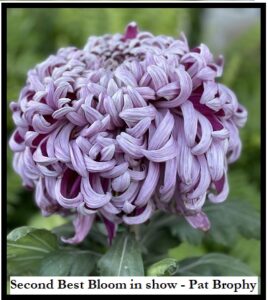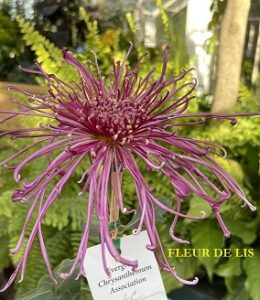Initially your mums will need lots of T.L.C., by way of adequate sunlight and protection from wind, cold, curious dogs and cats, etc. Place your plants under any kind of cover that will shelter them from the elements i.e. Cold frame- Green house- house eaves – patio – carport- propagation cover. If necessary return them to shelter in evenings and out into sun during daylight.
SOILS
Our club uses M & R soilless mix that is available at a discounted price to ECA club members. This mix is used with very few additives from start to finish. In final stages we typically mix the soilless with a good compost or good loam in a proportion of 40% compost and 60% soilless. This holds moisture better.
WATERING
Water when the pot seems dry and/or the leaves show signs of wilting. In the early stages water sparingly, with an occasional thorough watering after which let pot set till it dries out again. Wet roots (wet feet) are a major enemy in March and April so be sure to keep them on the dry side. As you pot on your mums not all plants require the same water frequency, and those in plastic pots will not need watering as often as those in clay. The clay pots tend to dry out more quickly, which is why clay pots are recommended for all potting’s through 6”. By the time we go to 9” pots it’s generally much warmer and plastic pots are an acceptable alternative. In the early potting’s, expect to water sparingly about twice a week, Daily watering is normal during the warm summer growing season.
Fertilizers and Supplements
Mums like a mild fertilizer. Most Rose fertilizers work well. Start adding a small amount of fertilizer to supplement the soilless mix at each potting and about every three weeks after each potting. We recommend 3 different soluble fertilizer formulations:
1. March, April and May: 12-45-10 or 9-45-15 – low on nitrogen and high on phosphorous for strong root development. Use up through 6” pots.
2. June July and August: 20-10-20 – A very good formulation for the mid-season where strong plant structure and foliage are developed. Use in Final pots until bud formation.
3. September and October: 15-10-30 Potash special. Use during bloom formation, Sept and Oct. the high Potash hardens off the plant and enhances bloom formation, luster and life.
March, April, and May:
Be sure your plants have adequate moisture before you add any fertilizer to avoid burning the roots. The goal in the early stages of plant development is to develop a strong root system, so a fertilizer low in nitrogen and high in phosphorus should be used at the strength of one-half to 1 teaspoon per gallon once or twice a week. The Club recommends the 12-45-10 fertilizer listed above. Alfalfa meal and Fish products are also good amendments that can be used throughout the growing season to improve the general strength and health of the plants.
June, July and August:
When the mum is moved to the final pot switch to 20-10-20 fertilizer (item 2 above). Normal application rate is at the strength of one teaspoon per gallon, weekly. As the summer progresses along the rate can be increased to as much as 2 tsp/gallon for some varieties (mostly #1s and #2s). Be selective in fertilizing your plants, since some varieties and colors require less than others. In general, reds and purples do better with less fertilizer. Also pay attention to the leaf texture. If you are unable to curl a leaf around your finger because it is too stiff or brittle, reduce or eliminate fertilizer until leaf is more pliable.
September and October:
After the bud has been taken (all surrounding and lower budlets removed) discontinue fertilizer for2-3 weeks. Then resume at approximately half strength i.e. ½ tsp per gal, using the Potash Special fertilizer throughout the remainder of the bloom cycle It is also recommended that a supplemental potash feeding using sulfate or murate of potash be applied, (dry) starting the first of Sept. at the rate of ¼ teaspoon per pot 2 times in order to get the hardening off process started
TRANSPLANTING
Mums grown in pot’s are transplanted between 3-4 times throughout their growing cycle. When a nice root ball has formed plants in 2” pots are potted in to 4” pots; plants in 4” pots go to 6” pots; and plants in 6” pots are potted in to by 8” pots. Clay pots are preferred through 6” size as they allow the root ball to dry out more readily than a plastic pot and keeping the root ball somewhat moist, but not wet is a major challenge in March and April. Plastic pots are used by some growers for the final potting as they are somewhat lighter than clay, considerably cheaper, and require less frequent watering in the hot summer weather. Section One and Two cultivars should be grown in 9” or 10” pots. Section 3 cultivars are generally grown in 8” pots, the potting on process is relatively simple:
Determine if the plant is ready to repot by inverting the pot, holding the plant with fingers just below the foil surface, and taping the edge on a hard surface i.e. a bench edge. When the root ball emerges, check to see if roots extend in a ring around the bottom. If they do, you are ready to re-pot into the next larger size. If the roots are still on the scarce side, place the plant back the pot and wait for future growth.
-Repot into next larger pot. The pot should be clean and soaked then dried to a semi dry condition. The M&R potting mix with a little alfalfa meal mixed in should be moist, but not wet. Add a small amount of the mix to the bottom of the new pot so that the top of the root ball, when sitting on this bottom layer, will be 1/2 inch from the top of the new pot.
Fill in around the plant with M&R mix and firm down very gently sufficient to hold the root ball in place. Don’t forget to record transplanting date on the backside of the plant tag.
Set your newly potted plant outside in a sunny location protected from wind and rain. The south side of a white house is ideal. A cold framewith plenty of ventilation works well for 4” pots. Six inch and larger pots will have to sit outside. Your plants will have to be staked to keep them from falling over. Initially you can tie the growing stem to a 12-18 inch stick. Later on you will need 3, 4, or 5 foot stakes.
Alternatively you can transplant your mum into a sunny location in your garden. This works well for many Early English mums and some other American varieties, but be aware that these are earlier blooming varieties that typically bloom out before the bad weather of late Oct. So you can often get good blooms without weather protection. Remember the mum likes a light loamy soil with good drainage and plenty of sunlight. The plants can be set out safely in mid to late April. The best approach is to carry the plants through 4 inch pots, then set them out into the garden.
Stopping (Pinching)
From sometime between late April and early July, most of the mums need to be stopped. This is the process of removing the growing tip of the mum for the purpose of producing laterals. Usually only an inch or two is sufficient, but more can be removed if the plant appears spindly or weak. See Figure 1 and 2. Once done, two, three, or more side shoots, called laterals, will progressively emerge from the leaf axils below the stop. Since you are new at this game, it’s a good idea to initially keep the upper three to six laterals depending on the cultivar. Remove all others. Stopping twice is beneficial for some varieties to keep the plant’s height reduced, to increase the number of laterals, or to improve the bloom’s form and size. Check with your coach about what varieties this applies to before making double stops. Otherwise a single stop is usually sufficient.
The stopping date is used primarily to time the mum growing so that it should reach full bloom at the time of our show (the last week of October). Basic stopping lists are distributed within the club to get started. Each grower eventually develops a stopping list of their own reflecting how the mums progress within his or her particular location light availability etc. For those mums planted in the garden (not pots), it’s a good idea to stop plants in mid to late Be sure to wear chemical proof gloves, a good respirator and safety glasses if you use chemicals. Note: Never spray a plant and expose it to sunshine immediately. (It is best to spray in the evening, after sundown). Be especially careful with atomized sprays, always protect your lungs.
STAKING
From the time the laterals are 12 to 16 inches long you need to stake each lateral using stakes 3to 5 foot long. Bamboo or thin wooden stakes work well. The stake end should be sharpened for easy penetration into the soil and to prevent tearing the roots. The stake should be close to the lateral and tied to the stem in 3 to 4 places as the lateral grows, much like tomatoes are staked. When you have secured the terminal bud, the top of the stake should 1 to 4 inches below the bud. If the chosen stake is too long or too short you can replace it with one the correct length. Alternatively you can cut the stake off with pruners if too long, or tie another stake on if too short
TOP DRESS
As your mums grow in height and width, the roots do likewise, with many of them surfacing at the top of the pot. These top roots should be covered with a handful or two of soilless into the pot about once a month from August on throughout the growing season. If the pot becomes full, insert a piece of plastic bender board around the inside collar of the pot. This is a very important step to obtain larger blooms, so if one wants to get on the trophy table they had better heed this advice.
SHADING (for Charms and Cascades Section 12)
In order to get most of the buds on the plant to bloom at the same time, and to time the bud formation so as to have the plant in full bloom at show time, each pot has to be completely covered so as to limit the number of daylight hours the plant receives simulating a shorter growing day(onset of Autumn). This accelerates bud development. Bringing the plants into a dark garage or setting a table over the plants and enclosing them with black plastic may accomplish this. Each mum variety has a different response time and only through experience will a grower learn when to start this process. However this covering needs to continue for approximately 21 days, allowing only 14 ½ hours daylight each day to initiate the formation of flower buds. Many Charms (No. 12) such as Morning Star, Bullfinch and Ignore Vale have a 14-hour response time spread over 3 weeks. Covering the plants at 6:00 P.M. and uncovering them at 8:00 A.M may accomplish this. Some classes of cultivars require more shading. Our experienced growers then keep track of the time it takes your variety to be in full bloom
Sheltering
Early in the development of the flower bud a membrane covers it. As the flower bud grows larger the membrane will break and the color of the bloom will start showing.
It is now time to provide protection from early morning dews that are followed by hot sun, which can burn the bloom. Fortunately the pot grown mums can now be moved from the outdoor growing area into a finishing area where the blooms can be kept dry and protected from the elements. The finishing area might be a green house, a covered patio, a garage with East or south facing doors, overhanging eaves the basement if lighted, a spare bedroom etc. A very popular finishing shelter is a simple hoop house covered with 2-6 mil plastic and also covered with shade cloth to prevent overheating, and burning of the bloom. It is possible to line the inside with used bed sheets. This not only protects against sun and hear, it also absorbs the early morning that can otherwise drip on the flowers.
BLOOM STAGE
Check daily to note progress. Attach a slender support stake under the bud that is 16 to 18 inches long and 1/4th to 3/8 in. thick. Slender bamboo, or sawn strips of cedar shingle work well for this. Tie this stake to the stem directly under the bud, then tie the combined support stake and stem to your main lateral stake. Tie in 3 or 4 places using twistems. This stake will keep the bud/bloom sitting straight on top of the stem and keep the stem straight.. Look for signs of insects as characterized by small black turds (Earwigs); chewed or frayed petals (Slugs, and others) and insects crawling around (Aphids, white flies etc.) These need to be found and eliminated before they can get into the bulk of the bloom and ruin it completely. Note: It takes the typical bloom 4-6 weeks to develop from membrane break to full flower, so aphids would have time to reproduce 5 or 6 times if not destroyed. Wow!
SHOW TIME
You will be given a copy of the Association Show Rules. Look through it and ask questions. If there are parts you don’t understand, consult with your coach, or other growers. Make an inventory of the blooms you plan to show and then decide what category they should be entered in. Check with your coach if you need help. Fill out a Novice Entry Tag (or indicate an N after the number class number) and attach it to the stake supporting the bloom with a “twistem. Cut blooms should have a stem below the base if the bud of 16” – 18” in height that’s the length of that support stake mentioned earlier. Also fill out the Show Entry Form and give it to the Show Chairman. Volunteering to be a Judge’s assistant or clerk can be very educational. In this assignment you will help in the placement of ribbons on the vases. Judges discuss the merits of a bloom or plant, which can be useful information to the Novice grower.
We invite you to join the Evergreen Chrysanthemum Association; to participate in our shared passion of growing and cultivating exhibition chrysanthemums; to cultivate new friendships; and to continue the legacy. Just as with Jack McGlashan’s first group… start with just 6 plants.
2024 Evergreen Chrysanthemum Association meeting dates:
Saturday, January 13th 10:00 am
Saturday, February 17th 10 am – plant starts
Saturday, March 9th 10:00 am
Saturday, April 13th 10 am
Saturday, May 11th 10:00 am
Saturday, June 8th 10 am
Saturday, July 13th 10:00 am
Saturday, August 10th 10 am
Saturday, September 14th 10:00 am
Saturday, October 12th 10 am
Saturday, November 16th Banquet -TBD
Saturday, December 14th 10 am
There are benefits to joining the
Evergreen Chrysanthemum Association including:
Cultivars available first to ECA club members
Club members get discounted rates on cuttings, fertilizers and other growing supplies
Club members receive individualized Coaching





Hello Ha, Thank you for your interest in Evergreen Chrysanthemum Association. I have sent you an email containing ECA membership information. Happy Gardening. Sue
Please resend the membership info again. I never received the information. It must have went to the spam folder or something.
Thanks,
Ha
Thank you for your interest in Evergreen Chrysanthemum Association. Membership information has been sent to [email protected]
I would love to be a member.